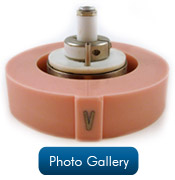Asphalt Binder Cracking Device
Overview
Simplicity and accuracy are the Asphalt Binder Cracking Device’s unique advantages in low temperature binder testing technology. Current American Association of State Highway and Transportation Officials (AASHTO) binder specifications cannot accurately measure the low temperature thermal cracking potential of modified asphalt binders.
One AASHTO specification (M320 Table 1) is fairly accurate when testing unmodified asphalt binders, but not when testing modified asphalt binders.
With increased use of polymer-modified binders in highway construction, AASHTO adopted a second asphalt binder specification (M320 Table 2). The binder thermal stresses are calculated using the test results of the Bending Beam Rheometer (BBR) at two or three temperatures. By comparing these thermal stresses with the strength of the asphalt binders, a cracking temperature can be estimated. This process involves assumptions of many parameters, such as thermal expansion coefficient (α) and time-temperature shift factor (aT) of asphalt binders.
Furthermore, accurate measurement of asphalt strength at low temperature has not been possible.
This is the point where Dr. Kim and EZ Asphalt Technology have made asphalt binder testing simple and accurate by creating the Asphalt Binder Cracking Device (ABCD).
ABCD Extended Summary (PDF)

